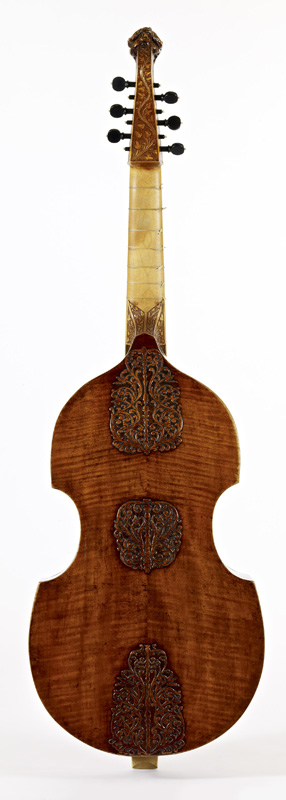
The Viola da Gamba
“The viola da gamba is not the ancestor of the cello!”
I begin every lecture, discussion, or demonstration that comes up with that statement. It seems to be the most prevalent misconception about this family of instruments that is so dear to me.
The viola da gamba is a bowed stringed instrument that flourished from the 16th to 18th centuries in Europe. Its three commonest sizes of treble, tenor and bass span a register similar to their cousins, the violin family’s violin, viola and cello. Unlike the violin family, its fingerboard has seven moveable, therefore tuneable frets that give the instrument a clear, resonant tone. The viol usually has six strings, but the French added a seventh bass string in the late 17th century, and in the 18th century, French luthiers also expanded the family’s range on the high side by creating the five-string pardessus de viole. The standard tuning is in fourths with a major third in the middle. For example, from the bottom, the six-stringed bass viol is tuned D-G-C-e-a-d′.

The bodies of the two families of stringed instruments differ in subtle but significant ways. Usually the back of a viol is flat with a fold towards the top, and the shoulders slope more than the violin shape. The back and top do not overhang the ribs, and the sound holes are most often cut in a C shape. Viols are more lightly constructed than the violin family and the result is a softer, more resonant sound.
The viol (viola da gamba is the Italian term) is held between the knees and supported by the legs (gamba means leg in Italian). All sizes are held this way including the tiny pardessus. The bow is held in an underhand grip not unlike a spoon or chopsticks.
The viola da gamba was often highly decorated, especially on the fingerboard and tailpiece, and carved heads often took the place of a scroll. These heads represented either creatures or people and usually are typical of the decorative style of the period. The viol was an instrument of the upper class and aristocracy and the finest-sounding instruments often have the most lavish and beautiful decoration.
The viola da gamba was used extensively in the late 16th to mid-17th centuries in ensemble music such as consorts, with the different sizes used in contrapuntal writing for between two and six voices. English composers such as Christopher Tye, William Byrd, Orlando Gibbons and William Lawes wrote intellectually challenging as well beautiful music for these combinations of viols. The bass viol flourished as the solo instrument for a number of virtuosi whose compositions form the bulk of the solo literature in the 16th and 17th centuries. Marin Marais, Johann Schenk and Christopher Simpson were some of these famous performer/composers. By the 18th century major composers such as Bach and Telemann were writing for the viol as a solo instrument. Throughout its history the viol was also used in ensemble with other instruments, either as a part of a mixed consort, in trio-sonatas as one of the solo voices or as a partner with voice in arias. Another significant use of the viol was as a basso continuo instrument, to realize a bass line notated on a single stave with figures indicating a harmonic structure to be improvised above it. Most figured bass parts do not specify which bass instrument is to be used to double the keyboard bass line, and the viol can often be the best choice. Only when large concert halls and public concerts became the norm at the end of the eighteenth century, and the viola da gamba could not compete with the louder violin and cello, did it go out of favor.
The twentieth century saw a resurgence of interest in the viol. At the beginning of the century, one center of the revival was in Brussels, another in Germany, and perhaps the most well known was in England with Arnold Dolmetsch and his family. Several of the instruments in this collection were owned and preserved by that family. By the end of the last century, the performance of early music on original instruments was common, and there are now scores of makers of instruments based on historical models. However antique viols are still a rarity and the Caldwell Collection is one of the largest in private hands in the world.